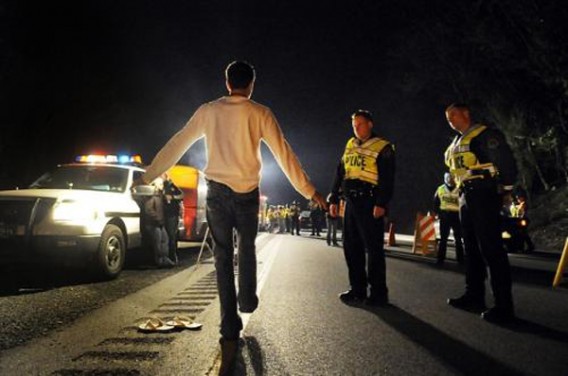DUI Field Sobriety Test
Information regarding the standardized field sobriety test a person is asked to take when stopped for a DUI.

Examining the Use of Field Sobriety Testing, in DUI Cases
Driving under the influence (DUI) continues to be a concern for safety, and law enforcement officers often utilize field sobriety tests (FSTs) to determine a driver’s level of impairment. These tests are crucial in DUI investigations and subsequent legal processes. Here is an overview that delves into their significance.
Admissibility in Legal Proceedings
Field sobriety tests serve as evidence in DUI trials. However, their acceptance in court depends on how they are conducted. The Standardized Field Sobriety Tests (SFSTs) established by the National Highway Traffic Safety Administration (NHTSA) include:
- The walk-and-turn test
- The Horizontal Gaze Nystagmus (HGN) test
- The one-leg Leg Stand test
When administered correctly, SFSTs are typically considered admissible in court. Nonetheless, challenges to their admissibility may arise if the administering officer deviated from protocols or if external factors, like conditions or rough terrain, could have influenced the results.
Legal Implications of Refusing a Field Sobriety Test
Refusing to take a field sobriety test carries its own set of implications. Due to implied consent laws, refusal can lead to mandatory license suspension in many states. This means that by accepting the privilege of driving, motorists are assumed to consent to such testing when lawfully requested. Refusal can also be introduced as evidence in court, possibly suggesting consciousness of guilt.
Standardizing Field Sobriety Tests
The National Highway Traffic Safety Administration (NHTSA) has set up three field sobriety tests to ensure an evaluation of impairment. These evaluations include the Horizontal Gaze Nystagmus (HGN) Walk and Turn and One Leg Stand. They aim to assess an individual’s balance, focus, and physical capabilities—all factors that can be impacted by alcohol or drugs.
Horizontal Gaze Nystagmus (HGN)
During the HGN assessment, an officer observes how well a person’s eyes follow a moving object like a pen or flashlight. The officer looks for eye jerking movements (that become more noticeable with increased alcohol consumption.
The NHTSA says that 68 percent of individuals who exhibit two or more indicators from the above list while performing this test will have a BAC of 0.10 or greater. To find out how many drinks it will take to reach a blood alcohol content of 0.10 checkout our free BAC calculator.
Walk-and-Turn Test Procedure
In the walking test, individuals are asked to take nine steps while keeping heel-to-toe contact along a line. They then pivot on one foot before retracing their steps.
The police officer can spot signs of impairment, like having difficulty keeping balance or following instructions.
- If the suspect cannot keep their balance while listening to the officer’s instructions.
- The suspect begins before the officer finishes his instructions.
- The suspect stops while walking the line to regain their balance.
- Does not touch heel-to-toe with each step.
- Uses their arms for balance.
- The suspect loses their balance while turning.
- The suspect takes the incorrect number of steps.
The NHTSA says that 68 percent of individuals who exhibit two or more indicators from the above list while performing this test will have a BAC of 0.10 or greater. To find out how many drinks it will take to reach a blood alcohol content of 0.10, check out our free BAC calculator.
One-leg Stand Test Procedure
In the one leg stand test, the person must lift one foot six inches off the ground. They should then count aloud until instructed otherwise. Signs of impairment may include swaying, using arms for support, or hopping.
- Swaying while balancing on one foot.
- The suspect is using their arms for balance.
- The suspect is hopping to maintain their balance.
- The suspect is putting their foot down during the test.
The NHTSA says that 65 percent of individuals who exhibit two or more indicators from the above list while performing this test will have a BAC of 0.10 or greater.
The more indicators that the officer receives during the field sobriety tests, the more convincing the testimony will be in court. Since the SFST is administered according to national standards, the SFST has greater credibility in court.
Accuracy of Field Sobriety Test Results
While these test outcomes are typically accepted in court, their accuracy may be questioned. Legal experts point out that law enforcement officers interpretations of these tests may involve some subjectivity. Therefore, the training and experience of the officer administering the test play a role. Factors such as how instructions were given and how well they were understood and carried out by the individual being tested can impact how these tests are viewed in a DUI case.
Legal Ramifications of Declining a Field Sobriety Test
Understanding the consequences of refusing to take part in a field sobriety test is important. Having a grasp on these assessments is crucial, for understanding DUI incidents and subsequent legal processes. It’s important to realize that each DUI case can develop based on factors. When facing field sobriety tests, it’s important to be aware of your rights, understand the guidelines, and consider possible consequences to handle such situations effectively.
Additional DUI Resources
- DUI First Offense – Detailed first offense information, including punishments after a first offense DUI.
- DUI Classes – Get signed up for your DUI class now.
- SR22 Insurance – Learn everything you need to know about SR22 filing requirements with the DMV and find out how you can save hundreds of dollars each year on your SR22 insurance.
- DUI Laws & Lawyers – Contact one of our DUI lawyers today to discuss your pending DUI case. Also, find out information regarding DUI laws.
- Bail Bond Agents – Contact a bail bond agent to get out of jail now.
- Non-owner SR22 Insurance – If you need an SR-22 filing, but don’t own a vehicle, you need to get a non-owner policy.
